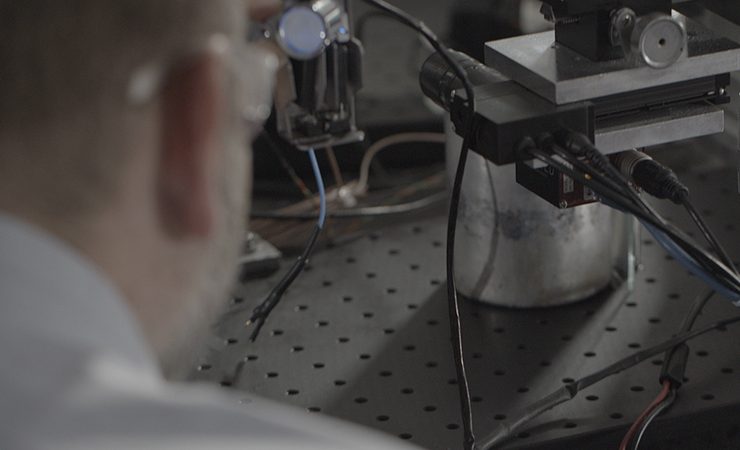A relatively small number of chemicals are used to formulate inks, and so understanding how these chemicals interact and behave in different environments, and in different printing processes, is key to ensuring consistent, reliable print quality.
With this in mind Domino has closely examined the jetting process in continuous inkjet (CIJ) printers, uncovering the root cause of an issue that had puzzled the coding and marking industry for decades.
‘At Domino, we are constantly seeking new ways to advance our products, solutions and services to deliver the best performance and value for our customers,’ notes Dr Josie Harries, group programme director at Domino Printing Sciences. ‘R&D efforts include a strong focus on developing new reliable ink formulations and looking at how we can optimise inks for different production environments.
‘Achieving a clean, crisp code on a beverage canning line requires a very different type of ink to that used for harsh industrial applications, like printing on cables or cement bags. To ensure reliability, it’s therefore important to consider the way an ink behaves under different conditions, and any subsequent impact on printer performance.’
As part of an ongoing project to better understand the jetting process in CIJ printers, Domino looked to examine how inkjet formulations behave in every type of atmosphere – from hot to icy cold, sticky to dusty – to reflect all the variables likely in customers’ plants, so as to identify which formulations make reliable inks.
‘One specific area that we have looked to explore is particle build-up – that is, where small ink deposits accumulate on the deflecting plates within a CIJ printhead. The accumulation of particulate matter is an issue for manufacturers using CIJ printers, as this necessitates more frequent cleaning, and, if left to build-up for an extended period, can cause downtime.
‘Particle build-up is inherent to CIJ printers, but it is not often spoken about in the coding and marking industry. Historically, certain inks developed for use in inkjet printers have been more prone to build-up, and over the years, different printer designs have been developed to minimise the issue. That said, concrete evidence as to why the issue occurs, and so a real understanding of how to overcome it, has always been missing. Until now.’
As the material generated during the build-up process is very small, it has been historically difficult to visualise. As part of Domino’s research, the company sought to uncover the root cause of particle build-up by examining the phenomenon in close detail. To do this, Domino collaborated with Cambridge University Institute for Manufacturing (IfM) to study the jetting process at the micro level, to gain a clearer understanding of exactly what was occurring.
Collaborating for success
In partnership with IfM, a series of high-speed visualisations were conducted to observe build-up occurring within the printhead. The experiments used illuminating lasers and smoke to provide detailed imagery of the particles within the inkjet stream. The visualisations revealed that the particle build-up stems from small satellite droplets that break off from the main inkjet stream and are subsequently charged by the electrostatic field generated by the deflecting plates. Charged particles build up in the printhead, resulting in the need for more regular washing to ensure that the printer keeps working.
Dr Harries notes, ‘The visualisation technique allowed us to observe the phenomenon and monitor the behaviour of the satellite droplets in different formulations, and with changes to the settings used to run the printhead, so we could better understand which factors contribute to particle build-up.
‘Our work with the IfM provided a route to understanding particle build-up, and by extension, the role that ink formulation plays in inkjet reliability.
This has allowed us to work to optimise our ink designs to prevent build up occurring by avoiding chemicals that have a propensity to have this issue – we can use these techniques very early in the development process to screen out materials rather than discovering the issue late in the project. It has also allowed us to explore where we can develop in-house capabilities, similar to the visualisation techniques employed by the IfM, so that we can conduct further research as part of new ink development processes. That way, we can continue to provide reliable solutions for our customers in the future, as and when new production processes arise.’
Domino sees the benefit of this research as being two-fold: it helps the industry to better understand how to design printers that offer better uptime; and it informs the ink formulation process so that R&D teams can develop inks that function reliably within specific printers, and in specific production environments.
As Dr Harries explains, ‘Exploring the origin of particle build-up in CIJ printers is one of our latest examples of R&D success, which will go on to benefit our customers and the wider coding and marking industry. It is also a small part of much wider efforts occurring at Domino to develop a better understanding of how printers perform, and to uncover new and improved ways of developing reliable solutions, quickly and efficiently.
‘Collaboration, whether with the IfM, our colleagues, or external partners, is key to our R&D efforts in this area. An issue, or idea, studied in isolation will only progress so far, restricted by the knowledge, experience, and technical capabilities of one entity. By working with the IfM we were not only able to extend our existing testing capabilities, but also benefitted from a broader knowledge base.’
This article was first published in the November/December 2021 issue of Digital Labels & Packaging, which you can read online here; register here to receive future issues of the magazine, for free






